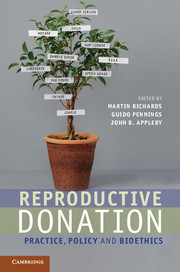Book contents
- Frontmatter
- Contents
- Contributors
- Acknowledgements
- 1 Introduction
- 2 The biology of donation
- 3 Ethics for reproductive donation
- 4 Parenthood – whose right is it anyway?
- 5 Reproductive donation
- 6 UK and US perspectives on the regulation of gamete donation
- 7 Gamete and embryo donation
- 8 The legal and ethical regulation of transnational donation
- 9 Balancing ethical criteria for the recruitment of gamete donors
- 10 Challenges in intra-family donation
- 11 ARTs and the single parent
- 12 Reproductive donation and justice for gay and lesbian couples
- 13 Is disclosure in the best interests of children conceived by donation?
- 14 Identifiable donors and siblings
- 15 Ethical issues in embryo donation
- 16 Reproduction through surrogacy
- 17 Some conclusions regarding the interaction of normative and descriptive elements in reproductive donation
- Index
- References
15 - Ethical issues in embryo donation
Published online by Cambridge University Press: 05 August 2012
- Frontmatter
- Contents
- Contributors
- Acknowledgements
- 1 Introduction
- 2 The biology of donation
- 3 Ethics for reproductive donation
- 4 Parenthood – whose right is it anyway?
- 5 Reproductive donation
- 6 UK and US perspectives on the regulation of gamete donation
- 7 Gamete and embryo donation
- 8 The legal and ethical regulation of transnational donation
- 9 Balancing ethical criteria for the recruitment of gamete donors
- 10 Challenges in intra-family donation
- 11 ARTs and the single parent
- 12 Reproductive donation and justice for gay and lesbian couples
- 13 Is disclosure in the best interests of children conceived by donation?
- 14 Identifiable donors and siblings
- 15 Ethical issues in embryo donation
- 16 Reproduction through surrogacy
- 17 Some conclusions regarding the interaction of normative and descriptive elements in reproductive donation
- Index
- References
Summary
Introduction
The use of a donated embryo in assisted conception was first reported by Trounson et al. in 1983, when a female patient was successfully treated using an embryo created from a donor egg and donor sperm. It was deemed by the clinicians involved to be no different from egg or sperm donation, and indeed they postulated that it could be less problematic in that there would be no inequality in the genetic contributions of the parents (Trounson et al., 1983). However, embryo donation (strictly defined as treatment using donated embryos) raises distinctive ethical concerns and questions. In this chapter we will focus on three areas which we consider key to debating these concerns, covering regulatory issues, the structure of the practice of embryo donation and ARTs generally, and the individual perspectives of recipients and donors. The first topic to be examined is the disparity in parenting selection criteria between embryo donation and adoption, two processes that share a structure whereby both result in a couple parenting a genetically unrelated child. In 2002 we examined the size of this disparity and concluded that it was not justified (Widdows and MacCallum, 2002). Here we revisit and update the debate, in the light of changing laws regarding donor anonymity and changing social attitudes towards donor conception. The second key area relates to the decision whether to donate embryos in the first place. We investigate the extent to which the moral status of the embryo, as frequently debated in ethical analyses, has any influence on decisions of potential donors, and the need for consent to donation to be truly fully informed. In addition, there are ethical issues relating to the exploitation of donors (or ‘vendors’), particularly poor vendors, which are unlikely to be addressed by improving informed consent. Finally, we address matters relating to the way in which embryo donation impacts upon society’s perceptions of children. Developments in the ability to choose characteristics of donors, and the varying laws existing in different jurisdictions worldwide, have produced structural changes in the practice of ARTs. Increasingly, the ethical debate has focused on ‘reproductive tourism’ and the ethical disquiet arising from this global market. Central to this argument are increasing concerns about the commercialization of reproductive treatment, and the commodification which may result for the ‘products’ of this trade: the children created using these technologies.
- Type
- Chapter
- Information
- Reproductive DonationPractice, Policy and Bioethics, pp. 270 - 288Publisher: Cambridge University PressPrint publication year: 2012
References
- 7
- Cited by



